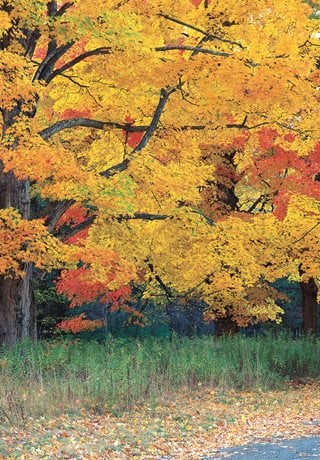Colonnade Apple Tree - Gardening Advice
Q: I like the formality of espaliered apple trees, but I have little room for limbs to fan out. What do you think of the apple variety called colonnade, which is supposed to stay narrow, like a bushy pole with short branches? — Ernie Crooks, Calgary, Alberta, Canada
A: Colonnade is a trademarked name for four unusual varieties. A single tree actually looks like a maypole that has sprung to life, and a row of these trees does suggest the leaf- and fruit-bearing pillars of a roofless colonnade. If you have a spot that gets plenty of sun, and you’re prepared to do the regular pruning that any apple tree needs, then Colonnade might be just the thing.
The four closely related varieties are all offspring of one mutant branch discovered on a ‘McIntosh’ apple tree in British Columbia in the 1960s. When buds from this branch were grafted onto the rootstock of other apple varieties, they produced trees with extraordinarily upright growth, something like a Lombardy poplar. Left alone, this tree will become a dense thicket of vertical shoots, although the Colonnades’ peculiar growth habit also makes them fairly easy to prune into a pillar that’s only 2 feet wide and short enough — about 8 feet — to tend with a stepladder, even though the trees are grafted onto strong-growing M111 rootstock. With that sturdy anchor, they don’t need the support of a trellis and won’t blow over easily, unlike trees grafted onto dwarfing rootstock (a standard technique for stunting apple trees grown as espaliers).
With the Colonnades, you sacrifice much of the flexibility, both physical and aesthetic, that other apple varieties offer for intricate espalier patterns. You are restricted to the simple parallel lines of “vertical cordon” forms, instead of expansive candelabras, which I consider too tricky for most novice espalier-trainers anyhow. Your choice in fruit characteristics is limited, too. All four Colonnades produce apples with soft white flesh that’s good for pies and sauce. Though every variety has its own distinct flavor, each is a variation on the traditional ‘McIntosh’ taste: tart yet mild. This is a genuine bonus, since modern espaliers are usually grown for looks first and fruit quality second. If the trim appearance of a wall of flowering and fruiting apples is what attracts you to these trees, then the Colonnades should suit you to a T. For the sharpest-looking row of trees, plant only one of the four varieties. To get fruit, though, you will need to have another variety for cross-pollination. This can come from different Colonnade variety or from an ordinary apple or crab apple tree that flowers at the same time and stands within 40 feet of your espalier.

